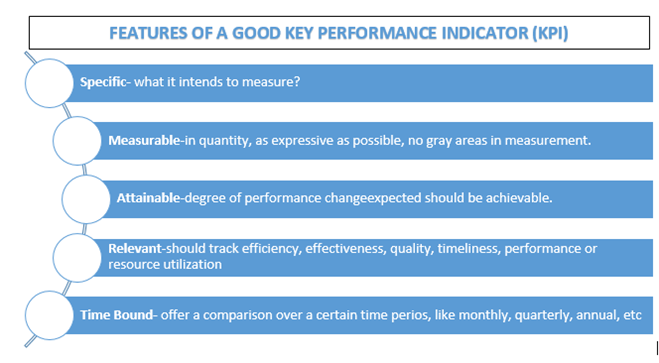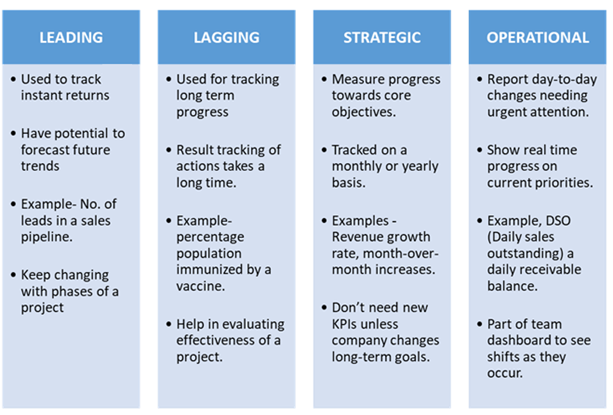What is a Key Performance Indicator?
Key Performance Indicator (KPI) is a measurement that helps the organization to understand the degree of achievement of personnel or an entity across various functional areas. Peter Drucker, the management sage, once said that “What gets measured gets done.” KPIs are thus, a way of gauging the competence and usefulness of a business/institution and its progress towards its aim. KPIs are strategic and help to focus on things that matter to achieve the end goals. KPIs help cut complexity linked to a performance by tracking and evaluating it. It reduces a large group of indicators to a small number of 'key' indicators. KPIs force organizations to measure how their strategy is fairing. KPIs show the workforce the requirements from the management.
Summary
- Key Performance Indicator (KPI) is an evaluation metric of organizational goals.
- KPIs are strategic and help to focus on things that matter to management.
- KPIs are SMART (Specific, Measurable, Attainable, Relevant, Time-bound) management pointers.
Frequently Asked Questions (FAQs)
Can any Business Metric be a KPI?
Not all metrics can be classified as a KPI. Basic quantitative data generated by a business that does not provide any business analysis are also not KPIs. KPIs are also not an exhaustive set of metrics and are refutable with business changes. If a metric is only historical information with no future use, it cannot be termed a KPI.
What are features specific to KPIs?
Each division or lineup within a business has different KPIs relevant to them, ranging from company-wide indicators to individual ones. Every KPI must fulfil SMART (Specific, Measurable, Attainable, Relevant, Time-bound) criteria. It should match with the ultimate goal. It is usually a numeric value to be achieved. To be an unbiased measurement, KPI must also have a defined data source and regular reporting frequency. KPI is an indicator of whether an organization is leading or lagging towards its’ aim.

Copyright © 2021 Kalkine Media Pty Ltd.
How do Key Performance Indicators (KPI) work?
Using KPIs means setting targets and tracking progress against them. It involves working to improve daily pointers, ultimately driving long term benefits. If a business uses KPI reports, setting up a good KPI structure and platform to share them becomes necessary. KPI dashboards have become more relevant in the current fast-paced organizations. Cloud-based companies generally embody a format where employees can review their data in real-time snapshots. Even startups like to share their core performance KPIs to get alignment from employees. Screens are placed on work floors highlighting real-time results.
Example-
A business wishes to track its Quarterly Recurring Revenue (QRR). It will know that quality leads, trials started, successful customer onboarding and other things will impact the success. So tracking a monthly or a daily number of all these activities becomes essential. Such reports or dashboards to track movements of key activities will ensure smooth, real-time tracking of quarterly targets.
Usually, businesses build a KPI tree for breaking down and visualizing the Organizational goals. In this approach, Strategic Goals are broken down into thematic goals. These are further broken into tactical objectives. Under each tactical objective, certain KPIs are defined. As one goes down, the levels s a one-to-many affiliation is established. These links are based on a cause and effect relationship.
Example-
To optimize profits, one needs to maximize revenue and costs. These themes are then broken as tactical goals of Income maximization, fixed/ variable cost controlling and managing margins. Under these KPIs shall be defined as Invoices generated during a period, Daily Sales Outstanding, monthly raw material costs as a percentage of sales, monthly distribution expenses, gross profit margin, EBIT, etc.
What are the types of KPIs?

Copyright © 2021 Kalkine Media Pty Ltd.
The above can also be classified as tangible and intangible KPIs. Tangible KPIs are number-based metrics, whereas Intangible KPIs look for qualitative aspect. Tangible KPI can be Customer Retention rate, EBIT Margin, Turnover, etc. Intangible KPI examples are Employee satisfaction, Net Promoter Score, Brand Loyalty, etc.
Importance of Key Performance Indicators (KPI)?
Setting key performance indicators generally is done in the strategic planning stage, whether yearly, quarterly or frequently.
- The goal is to confirm the entire organization is streamlined towards the same objectives.
- Ensuring alignment from top to bottom is the difference between achievement vs getting nowhere.
- KPIs track the specific performance of business objectives. Short and long-term targets are set to influence business processes.
- They help achieve the wider goals of the company. Ultimately help management & staff focus on goal influencing factors.
- Prove less is more in an era of superfluous data, which can often be confusing.
- The capacity to amend faulty processes becomes visible.
- KPIs portray a realistic and proportionate resource way of progress to a business.
- They help sum up complex situations numerically, driving towards results.
- Help build agreement and a common approach towards Strategic goals.
Actionable and accountable KPIs with clear and relevant targets are the best performance measures. Nothing can hamper achievement if the performance improvement process is ambitious and attainable. Reviewing and tweaking any business process, using timely scrutiny keeps performance at its’ best.
 Please wait processing your request...
Please wait processing your request...